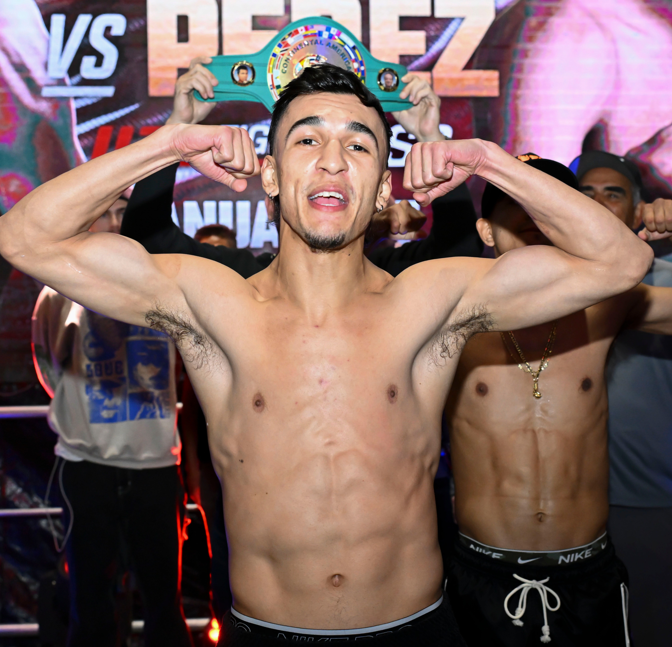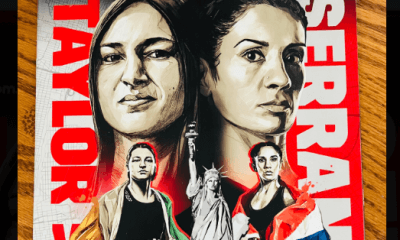Featured Articles
Undefeated Omar Trinidad Wins a Regional Title at the Commerce Casino

Omar Trinidad scored a knockout win despite the entangling style of Jose Perez to win a regional featherweight title and toss his name into the world title soup on Saturday in Commerce, California.
It wasn’t easy.
East L.A.’s Trinidad (15-0-1, 12 KOs) kept banging and chipping away at Victorville’s Perez (11-3-2, 5 KOs) in front of a large crowd at Commerce Casino on the 360 Boxing Promotions fight card.
Trinidad discovered quickly that the taller Perez’s style of charge and grab was not easy to decipher. Every round mirrored the previous round but the fighter from Boyle Heights used his left hooks and jabs to keep slightly ahead.
After battling evenly for six rounds the tide suddenly turned when both missed with rights and both pivoted and launched lefts. Trinidad landed first and down went Perez at the end of the seventh. He survived.
Perez did not survive the eighth as Trinidad connected with a right and down went Perez again. Though he beat the count the fight was stopped at 1:07 of the round. A stablemate of Callum Walsh, Trinidad wins the WBC Continental Americas featherweight title and enters the rankings.
“I feel great to win this title,” said Trinidad. “We’re in the rodeo now. I’m not under the radar now.”
Other Bouts
A battle between rugged super welterweights saw Eduardo Diaz (8-3) win by split decision after six rounds over Jose Manuel Gomez (4-4-1). Both were very strong fighters. Diaz was a little more active in a fight that saw no knockdowns.
David Romero (5-0-1) defeated Argentina’s Luciano Ramos (2-4) by unanimous decision after six rounds in a super lightweight marred by repeated fouls. Ramos repeatedly charged in with his head and held in almost every round. He was deducted three points all total. The scores were 60-51 three times for Romero.
Adan Ochoa (13-4) won by technical knockout over John Alimane (8-6-1) at the end of the second round. Alimane could not continue due to an injury.
Abel Mejia (3-0) remained undefeated by unanimous decision after four rounds versus Luis Montellano (3-13-3) in a super featherweight match.
Lupe Medina (5-0, 2 KOs) struggled against Lilian Almaraz (0-4) to win by majority decision after four rounds in a light flyweight bout. Though Medina showed quickness and technique, she was caught switching stances from southpaw to orthodox and had spells of inactivity. Scores were 38-38, 40-36 twice.
Brook Sibrian (2-0) scored a knockout win over Nikkia Williams (0-2) in the third round of a light flyweight contest. After a strong combination by Sibrian the referee stopped the fight at 1:29 of round three.
Rodrigo Mosquera (1-0) of Las Vegas won his pro debut by first round knockout over Michael Hernandez (0-3) in a lightweight match.
Photo credit: Lina Baker
To comment on this story in the Fight Forum CLICK HERE
-

 Featured Articles4 weeks ago
Featured Articles4 weeks agoAvila Perspective, Chap. 330: Matchroom in New York plus the Latest on Canelo-Crawford
-

 Featured Articles3 weeks ago
Featured Articles3 weeks agoVito Mielnicki Jr Whitewashes Kamil Gardzielik Before the Home Folks in Newark
-

 Featured Articles21 hours ago
Featured Articles21 hours agoResults and Recaps from New York Where Taylor Edged Serrano Once Again
-

 Featured Articles4 weeks ago
Featured Articles4 weeks agoCatching Up with Clay Moyle Who Talks About His Massive Collection of Boxing Books
-

 Featured Articles5 days ago
Featured Articles5 days agoFrom a Sympathetic Figure to a Pariah: The Travails of Julio Cesar Chavez Jr
-

 Featured Articles3 weeks ago
Featured Articles3 weeks agoMore Medals for Hawaii’s Patricio Family at the USA Boxing Summer Festival
-

 Featured Articles1 week ago
Featured Articles1 week agoCatterall vs Eubank Ends Prematurely; Catterall Wins a Technical Decision
-

 Featured Articles4 weeks ago
Featured Articles4 weeks agoRichardson Hitchins Batters and Stops George Kambosos at Madison Square Garden




















